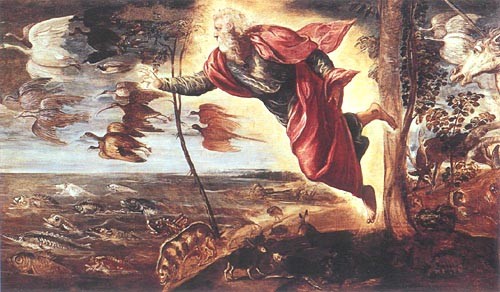mannerism
Tintoretto Creation of the Animals
The term mannerism describes the style of the paintings and bronze sculpture on this tour. Derived from the Italian maniera, meaning simply style, mannerism is sometimes defined as the stylish style for its emphasis on self – conscious artifice over realistic depiction. The sixteenth – century artist and critic Vasari — himself a mannerist — believed that excellence in painting demanded refinement, richness of invention, and virtuoso technique, criteria that emphasized the artist ‘s intellect. More important than his carefully recreated observation of nature was the artist ‘s mental conception and its elaboration. This intellectual bias was, in part, a natural consequence of the artist ‘s new status in society. No longer regarded as craftsmen, painters and sculptors took their place with scholars, poets, and humanists in a climate that fostered an appreciation for elegance, complexity, and even precocity.
Mannerism ‘s artificiality — its bizarre, sometimes acid color, its illogical compression of space, the elongated proportions and exaggerated anatomy of figures in convoluted, serpentine poses — frequently creates a feeling of anxiety. Works appear strange and unsettling, despite their superficial naturalism. Mannerism coincided with a period of upheaval that was torn by the Reformation, plague, and the devastating sack of Rome. After its inception in central Italy around 1520, mannerism spread to other regions of Italy and to northern Europe. In Italy, however, it remained largely a product of artists in Florence and Rome.
The character of mannerism continues to be debated. It is often discussed, and judged, in relation to the High Renaissance that preceded it. Some scholars see mannerism as a reaction to Renaissance classicism, while others regard it as a logical extension of it — a natural outgrowth of Michelangelo ‘s emphatic modeling or Raphael ‘s refinement. Already in 1600, mannerists were criticized for having willfully broken the unity of Renaissance classicism, its integration of form and content, its balance of aesthetic aims and ideas. Today, when classicism no longer has a unique claim on perfection, mannerism emerges more clearly as a link between the High Renaissance and the emotionally charged and dynamic baroque art that followed.
Mannerism, the artistic style which gained popularity in the period following the High Renaissance, takes as its ideals the work of Raphael and Michelangelo Buonarroti. It is considered to be a period of tecnical accomplishment but of formulaic, theatrical and overly stylized work.
Mannerist Art is characterized by a complex composition, with muscular and elongated figures in complex poses. Discussing Michelangelo in his journal, Eug'ne Delacroix gives as good a description as any of the limitations of Mannerism:
” All that he has painted is muscles and poses, in which even science, contrary to general opinion, is by no means the dominant factor… He did not know a single one of the feelings of man, not one of his passions. When he was making an arm or a leg, it seems as if he were thinking only of that arm or leg and was not giving the slightest consideration to the way it relates with the action of the figure to which it belongs, much less to the action of the picture as a whole… Therein lies his great merit; he brings a sense of the grand and the terrible into even an isolated limb.”
Prominent Members
In addition to Michelangelo, leading Mannerist artists included Rosso Fiorentino, Pontormo, and Parmigianino.
By the late 16, there were several anti – Mannerist attempts to reinvigorate art with greater naturalism and emotionalism. These developed into the Baroque style, which dominated the 17.
Chronological Listing of Mannerist Artists
——————————————————————————–
Masters of the Fontainebleau (16)French Painter
Michelangelo Buonarroti (1475-1564)Italian Painter / Sculptor
Giovanni Girolamo Savoldo (1480-1548)Italian Painter
Il Pordenone (1484-1539)Italian Painter
Sebastiano del Piombo (1485-1547)Italian Painter
Domenico Beccafumi (1486-1551)Italian Painter
Jacopo Sansovino (1486-1570)Italian Sculptor
Alonso Berruguete (1488-1561)Spanish Painter / Sculptor
Correggio (1489-1534)Italian Painter
Baccio Bandinelli (1493-1560)Italian Sculptor
Pontormo (1494-1556)Italian Painter
Rosso Fiorentino (1495-1540)Italian Painter
Diego de Siloe (1495-1563) Spanish Sculptor / Architect
Giulio Romano (1499-1546) Italian Painter
Polidoro da Caravaggio (1500-1543) Italian Painter
Benvenuto Cellini (1500-1571) Italian Sculptor / Goldsmith
Jan Sanders van Hemessen (1500-1566) Netherlandish Painter
Niccolo Tribolo (1500-1550) Italian Sculptor
Perino del Vaga (1501-1547) Italian Painter
Agnolo Bronzino (1503-1572) Italian Painter
Parmigianino (1503-1540) Italian Painter
Francesco Primaticcio (1504-1570) Italian Painter / Sculptor
Juan de Juni (1507-1577) French / Spanish Sculptor
Andrea Palladio (1508-1580) Italian Architect
Danese Cattaneo (1509-1573) Italian Sculptor
Daniele da Volterra (1509-1566) Italian Painter / Sculptor
Francois Clouet (1510-1572) French Painter
Jean Goujon (1510-1565) French Sculptor
Francesco Salviati (1510-1563) Italian Painter
Lambert Sustris (1510-1560) Dutch Painter
Bartolommeo Ammanati (1511-1592) Italian Sculptor
Giorgio Vasari (1511-1574) Italian Writer / Painter
Niccolo dell’Abbate (1512-1571) Italian Painter
Pirro Ligorio (1513-1583) Italian Architect
Tintoretto (1518-1594) Italian Painter
Antoine Caron (1520-1598) French Painter
Luis de Morales (1520-1586) Spanish Painter
Giovanni Battista Moroni (1520-1578) Italian Painter
Alessandro Vittoria (1525-1608) Italian Sculptor
Luca Cambiaso (1527-1585) Italian Painter
Paolo Veronese (1528-1588) Italian Painter
Giambologna (1529-1608) Flemish / Italian Sculptor
Taddeo Zuccaro (1529-1566) Italian Painter
Giuseppe Arcimboldo (1530-1593) Italian Painter
Cornelis van Dalem (1530-1573) Dutch Painter
Vincenzo Danti (1530-1576) Italian Sculptor
Germain Pilon (1530-1590) French Sculptor
Sofonisba Anguissola (1532-1625) Italian Painter
Martin de Vos (1532-1603) Flemish Painter
Alessandro Allori (1535-1607) Italian Painter
Federico Barocci (1535-1612) Italian Painter
Lucia Anguissola (1540-1565) Italian Painter
Pierre Dumoustier the Elder (1540-1610) French Painter
Hubert Gerhard (1540-1620) Dutch Sculptor
El Greco (1541-1614) Greek / Spanish Painter
Federico Zuccaro (1542-1609) Italian Painter
Bartholomeus Spranger (1546-1611) Flemish Painter
Peter de Witte (1548-1628) Netherlandish Painter
Palma Giovane (1548-1628) Italian Painter
Il Nosadella (1549-1571) Italian Painter
Hans von Aachen (1552-1615) German Painter
Camillo Mariani (1556-1611) Italian Sculptor
Otto van Veen (1556-1629) Flemish Painter
Leandro Bassano (1557-1622) Italian Painter
Adriaen de Vries (1560-1626) Dutch Sculptor
Pietro Bernini (1562-1629) Italian Sculptor

